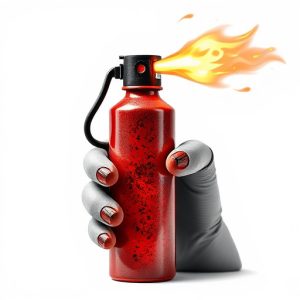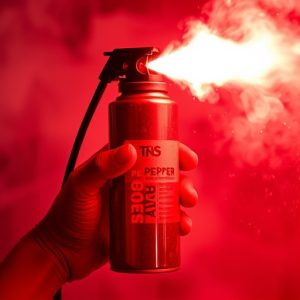Spray Safety Unveiled: Understanding Pepper Spray’s Properties and Safe Handling Against Flammability Risks
Pepper spray, containing oleoresin capsicum (OC), is a non-lethal self-defense tool that can incapa…….
Pepper spray, containing oleoresin capsicum (OC), is a non-lethal self-defense tool that can incapacitate an attacker by causing intense irritation to their eyes, skin, and respiratory system. Contrary to some misconceptions, pure capsaicin isn't flammable, but the propellants in aerosol pepper sprays can be combustible. To prevent fire hazards, it's crucial to handle and store these sprays carefully, keeping them away from heat sources and open flames. Safe use involves proper training to deploy the spray effectively while avoiding self-harm or affecting bystanders. In case of accidental discharge indoors, immediate ventilation is necessary to dilute the effects and protect individuals. It's important to understand that while pepper spray isn't inherently flammable like its pure form, it contains volatile compounds that could ignite if exposed to high heat or an open flame. Therefore, adhering to safe storage and handling practices, as well as following legal guidelines for use, is essential for responsible ownership and to ensure personal and environmental safety.
When considering personal safety, understanding the nature of defensive tools like pepper spray is paramount. This article delves into the essential aspects of pepper spray, addressing its properties, including its potential combustibility and safe handling, to ensure users remain secure. We explore the scientific composition behind pepper spray and its reaction with fire, clarifying concerns about whether pepper spray is flammable. Furthermore, we provide guidance on safe storage and use practices to prevent accidental flammability incidents, ensuring that this self-defense mechanism remains effective and risk-free. Join us as we navigate the critical safety protocols surrounding pepper spray.
Understanding Pepper Spray and Its Properties: combustibility and safe handling
Pepper spray, a commonly used non-lethal self-defense tool, is formulated with oleoresin capsicum (OC), a derivative of chili peppers. While it’s a powerful deterrent against potential assailants due to its intense irritant properties, there are critical safety considerations regarding its use and storage. One frequently asked question concerning pepper spray is whether it is flammable. Contrary to some misconceptions, pure capsaicin, the active component in pepper sprays, is not highly flammable under normal conditions. However, the propellant used in aerosol pepper sprays can be combustible and should be handled with care to avoid accidental ignition. It’s imperative to store these self-defense products away from heat sources and open flames to prevent any fire hazard. Safe handling of pepper spray involves understanding its properties beyond just its irritant effects. Users must receive proper training on its deployment, aiming to maximize effectiveness while minimizing the risk of injury to oneself or others. Additionally, in the event of an accidental discharge indoors, ventilating the area is crucial to dissipate the spray and reduce exposure to the incapacitating effects of the pepper spray, ensuring both personal safety and environmental safety. Understanding these aspects of pepper spray’s nature is essential for responsible ownership and use, contributing to its efficacy as a self-defense mechanism while mitigating potential risks associated with its combustibility and potent effects.
The Science Behind Pepper Spray and Fire: Chemical Components and Reaction Potential
Pepper spray, a non-lethal self-defense tool widely used for personal safety, is formulated with oleoresin capsicum (OC), a derivative of chili peppers. The chemical agents in pepper spray cause intense irritation upon contact with the eyes, skin, and respiratory system of an attacker. When discharged, the fine particulate of the spray induces a rapid inflammatory response, leading to pain, swelling, and an inability to see or breathe effectively, thereby incapacitating the assailant. The effects are usually temporary but can be debilitating during the active period.
Understanding the science behind pepper spray also involves addressing the question of its flammability. Contrary to popular belief, pure pepper spray is not highly flammable under normal conditions. However, like any aerosol, it can ignite if exposed to an open flame or high heat source due to the presence of volatile organic compounds. The risk of fire when using pepper spray should be carefully considered during deployment to avoid accidental injury or damage. It is crucial for users to handle and store pepper spray with care, keeping it away from heat sources and ensuring proper ventilation when using it outdoors. This understanding not only enhances safety during use but also provides insights into the potential reaction of pepper spray when exposed to fire, which is a critical aspect for both users and law enforcement personnel who employ this tool in various situations.
Safe Storage and Use of Pepper Spray to Prevent Accidental Flammability Incidents
When it comes to the safe storage and use of pepper spray, understanding its properties, including its flammability, is crucial for preventing accidental incidents. Pepper spray, while not inherently flammable in its liquid form, can become a fire hazard under certain conditions. To mitigate this risk, always store your pepper spray in a cool, dry place away from direct sunlight and heat sources. It’s imperative to keep it out of reach of children and unauthorized individuals, as improper handling can lead to dangerous situations. Additionally, when carrying pepper spray on your person, ensure it is in an appropriate holster or container designed to prevent overheating and exposure to ignition sources.
The use of pepper spray should be confined to self-defense or lawful crowd control measures as prescribed by local laws and regulations. In the event of discharging the spray, make sure to ventilate the area thoroughly to avoid inhalation of the pepper spray’s active ingredients, which can cause irritation. Furthermore, after using the spray, do not attempt to extinguish its residue with an open flame, as this could potentially reignite the particles and create a fire hazard. Always follow the manufacturer’s instructions for both storage and use to ensure safety and comply with legal standards regarding pepper spray usage. Understanding that ‘is pepper spray flammable?’ is not just a theoretical question but a practical concern, adhering to these guidelines can significantly reduce the risk of accidental flammability incidents.

